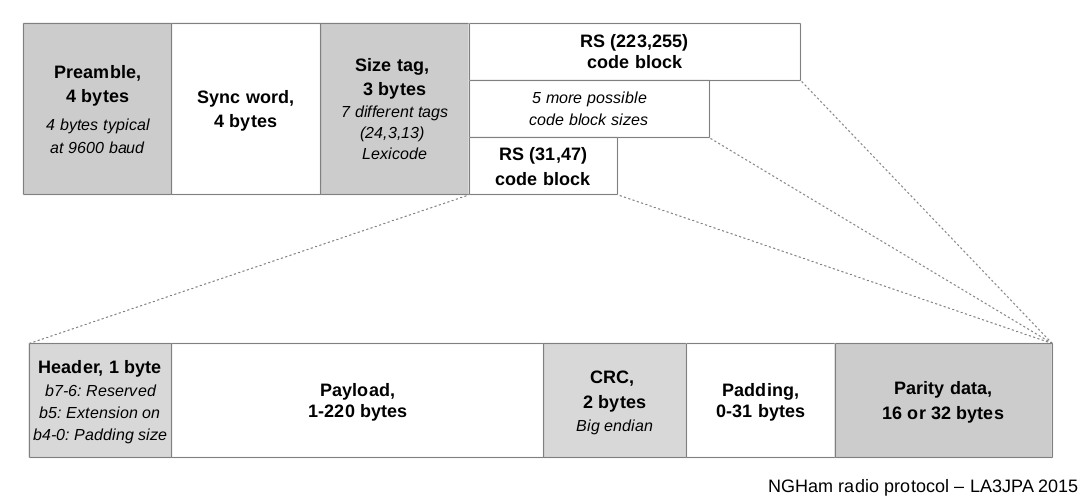INFORMATION FOR COMMUNICATING WITH ALDEBARAN-1
Aldebaran-1 communicates through VHF and UHF bands
COMMUNICATION: VHF
Beacon
The beacon is sent periodically and it provides the satellite basic statistics and data.
COMMUNICATION: UHF
Downlink and Uplink
The downlink provides complete satellite packets. The uplink allows telecommands to be received.
OPEN COMMANDS
Repeater
Open to the ham radio community, there are three open commands: ping, data request and message broadcast.
PROTOCOLS
NGHam, APRS and LoRa
Aldebaran-I uses three different protocols: NGHam, APRS and LoRa. APRS and LoRa for UHF and NGHam for VHF.
DATA
Decoding
Using the Aldebaran-1 custom-made software, it is possible to process and decode the collected data.
Tracking
Use the following information for tracking:
NORAD ID: 00000
International Designator: 0000-000G
TLE
Still not available
Orbit
Altitude: 500 km;
Inclination: 98.2°;
Cycle Repetition: xxxx days;
Orbit Period: 5640 seconds;
Ascending Node Local Time: xx:xx a.m.
BEACON DETAILS
- Frequency: 145.9 MHz
- Protocol: NGHam
- Modulation: GFSK
- Deviation: 1.2 kHz
- Baudrate: 1200 bps
- Output Power: 30 dBm (1 W)
The Beacon of Aldebaran-I transmits packets periodically, with 5 possible periods (accordingly to the overall energy level of the satellite):
| Energy Level | Beacon Period [s] |
|---|---|
| L1 (100% – 90% of total battery charge) | 10 |
| L2 (92.5% – 80% of total battery charge) | 10 |
| L3 (82.5% – 70% of total battery charge) | 20 |
| L4 (72.5% – 60% of total battery charge) | 30 |
| L5 (62.5% – 0% of total battery charge) | 30 |
In normal satellite operation, the beacon packets contains the following data:
| Field | Offset | Length [bytes] | Content |
|---|---|---|---|
| ID | 0 | 1 | Packet ID |
| Source Callsign | 1 | 7 | “xxxxxxx” |
| Timestamp | 8 | 4 | Variable |
| Battery cell 1 voltage | 12 | 2 | Variable |
| Battery cell 2 voltage | 14 | 2 | Variable |
| Battery current | 16 | 2 | Variable |
| Battery charge | 18 | 2 | Variable |
| Battery cell 1 temperature | 20 | 2 | Variable |
| Battery cell 2 temperature | 22 | 2 | Variable |
| Battery monitor temperature | 24 | 2 | Variable |
| Solar panel voltage (-Y and +X) | 26 | 2 | Variable |
| Solar panel voltage (-X and +Z) | 28 | 2 | Variable |
| Solar panel voltage (-Z and +Y) | 30 | 2 | Variable |
| Solar panel current (-Y) | 32 | 2 | Variable |
| Solar panel current (+Y) | 34 | 2 | Variable |
| Solar panel current (-X) | 36 | 2 | Variable |
| Solar panel current (+X) | 38 | 2 | Variable |
| Solar panel current (-Z) | 40 | 2 | Variable |
| Solar panel current (+Z) | 42 | 2 | Variable |
| EPS uC temperature | 44 | 2 | Variable |
If a fault on the OBDH module occurs (if the TTC module stops receiving data from it), only the EPS data are transmitted:
| Field | Offset | Length [bytes] | Content |
|---|---|---|---|
| ID | 0 | 1 | Packet ID |
| Source Callsign | 1 | 7 | “xxxxxxx” |
| Timestamp | 8 | 4 | Variable |
| Beacon uC Temperature | 12 | 2 | Variable |
| Reset counter | 14 | 2 | Variable |
| Last reset cause | 16 | 2 | Variable |
| Beacon radio temperature | 17 | 1 | Variable |
If a fault occurs in the OBDH and EPS modules, only the satellite ID is transmitted:
| Field | Offset | Length [bytes] | Content |
|---|---|---|---|
| Satellite ID | 0 | 7 | “xxxxxxx” |
DOWNLINK DETAILS
- Frequency: 437 MHz
- Modulation: GFSK
- Protocol: APRS
- Deviation: 2.5 kHz
- Baudrate: 1200 bps
- Output Power: 30 dBm (1 W)
-
- Modulation: LoRa
- Protocol: APRS and LoRa
- SF: 12
- BW: 125 Mhz
- Code rate: 8
- Preamb: 8
- Output Power: 30 dBm (1 W)
The Downlink of Aldebaran also transmits packets periodically (it contains a lot more data than the beacon packets), accordingly to the energy level of the satellite:
| Energy Level | Downlink Period [s] |
|---|---|
| L1 (100% – 90% of total battery charge) | 120 |
| L2 (92.5% – 80% of total battery charge) | 120 |
| L3 (82.5% – 70% of total battery charge) | 240 |
| L4 (72.5% – 60% of total battery charge) | 240 |
| L5 (62.5% – 0% of total battery charge) | none |
The content of each periodic downlink packet is described in the table below:
| Field | Offset | Length [bytes] | Content |
|---|---|---|---|
| ID | 0 | 1 | Variable |
| Source Callsign | 1 | 7 | Variable |
| Timestamp | 8 | 4 | Variable |
| Battery cell 1 voltage | 12 | 2 | Variable |
| Battery cell 2 voltage | 14 | 2 | Variable |
| Battery current | 16 | 2 | Variable |
| Battery charge | 18 | 2 | Variable |
| Battery cell 1 temperature | 20 | 2 | Variable |
| Battery cell 2 temperature | 22 | 2 | Variable |
| Battery monitor temperature | 24 | 2 | Variable |
| Solar panel voltage (-Y and +X) | 26 | 2 | Variable |
| Solar panel voltage (-X and +Z) | 28 | 2 | Variable |
| Solar panel voltage (-Z and +Y) | 30 | 2 | Variable |
| Solar panel current (-Y) | 32 | 2 | Variable |
| Solar panel current (+Y) | 34 | 2 | Variable |
| Solar panel current (-X) | 36 | 2 | Variable |
| Solar panel current (+X) | 38 | 2 | Variable |
| Solar panel current (-Z) | 40 | 2 | Variable |
| Solar panel current (+Z) | 42 | 2 | Variable |
| EPS uC temperature | 44 | 2 | Variable |
The downlink also transmits sporadic packets with the answers of the uplink telecommands.
UPLINK DETAILS
- Frequency: 437 MHz
- Modulation: LoRa
- Protocol: APRS and LoRa
- SF: 12
- BW: 125 Mhz
- Code rate: 8
- Preamb: 8
- Output Power: 30 dBm (1 W)
There are three types of uplink packets: Data request, ping and message broadcast. Each one is described in the table below:
| Command | Length [bytes] | Content |
|---|---|---|
| Data request | 8 | “dr” + flags |
| Ping | 8 | “@” + requester callsign |
| Message broadcast | Up to 28 | “B” + requester callsign + message |
- Data request: To request data of the satellite use this command. Selecting the flags, the user can download a set of past data of sensors or modules.
- Ping: This command can be used to test the communication with satellite. When received, the satellite transmits back a ping packet.
- Message broadcast: When received, the satellite transmits back the same content (an string with up to 20 characters) with the callsign of the source of command. This command can be used for communication between two or more ground stations.
REPEATER DETAILS
The two callsigns are showed below:
- 0PR8ALD
| Name | ID Code [1 byte] | Data [up to 220 bytes] | Data Size [bytes] | Total Size [bytes] | Acess Level |
|---|---|---|---|---|---|
| OBDH Data | 0x00 | OBDH/EPS data | 50 | 90 | Public |
| EPS Data | 0x01 | EPS data | 31 | 90 | Public |
| TTC Data | 0x02 | “xxxxxxx” | 10 | 58 | Public |
| OBDH Data | 0x03 | OBDH/EPS data | 50 | 70 | Public |
| EPS Data | 0x04 | EPS data | 31 | 51 | Public |
| TTC Data | 0x05 | “xxxxxxx” | 10 | 30 | Public |
| Telemetry | 0x10 | Flags (16 bits) + OBDH/EPS data | 212 | 266 | Public |
| Ping answer | 0X21 | Requester callsign (ASCII) | 7 | 58 | Public |
| Data request answer | 0x12 | Requester callsign (ASCII – 7 bytes) + Data (140 bytes) | 7 to 147 | 58 to 202 | Public |
| Hibernation feedback | 0x24 | Requester callsign (7 bytes) + Hibernation duration in hours (16 bits, MSB first) | 9 | 58 | Public |
| Charge reset feedback | 0x27 | Requester callsign (7 bytes) | 7 | 58 | Public |
| Message broadcast | 0x23 | Resquester callsign (7 bytes) + Destination callsign (7 byes) + Message (up to 38 chars) | 14 to 52 | 90 | Public |
- 0PR8ALD or any callsign
Name ID Code [1 byte] Data [up to 220 bytes] Data Size [bytes] Total Size [bytes] Acess Level Ping request 0x20 None 0 58 Public Data request 0x21 Data flags (16 bits) + Count (1 byte) + Origin (1 byte) + Offset (4 bytes) 8 58 Public Broadcast message 0x25 Destination callsign (7 bytes) + Message (ASCII, up to 38 characters) 7 to 38 90 Public
PROTOCOL DETAILS
NGHam
The figure below describes the NGHam protocol fields of each packet.

The only customized parameters from the protocol changed in Aldebaran-I, are the preamble and the sync. word, which are applied for both frequency communications:
- Preamble: 0xAA, 0xAA, 0xAA, 0xAA
- Sync. Word: 0x5D, 0xE6, 0x2A, 0x7E
More information about the NGHam protocol can be found here.
RADIO FORM
Did you manage to receive any signal from Aldebaran I? Please fill out the form and send the received packets. The Aldebaran team will check the data and update the database, adding your call sign!

